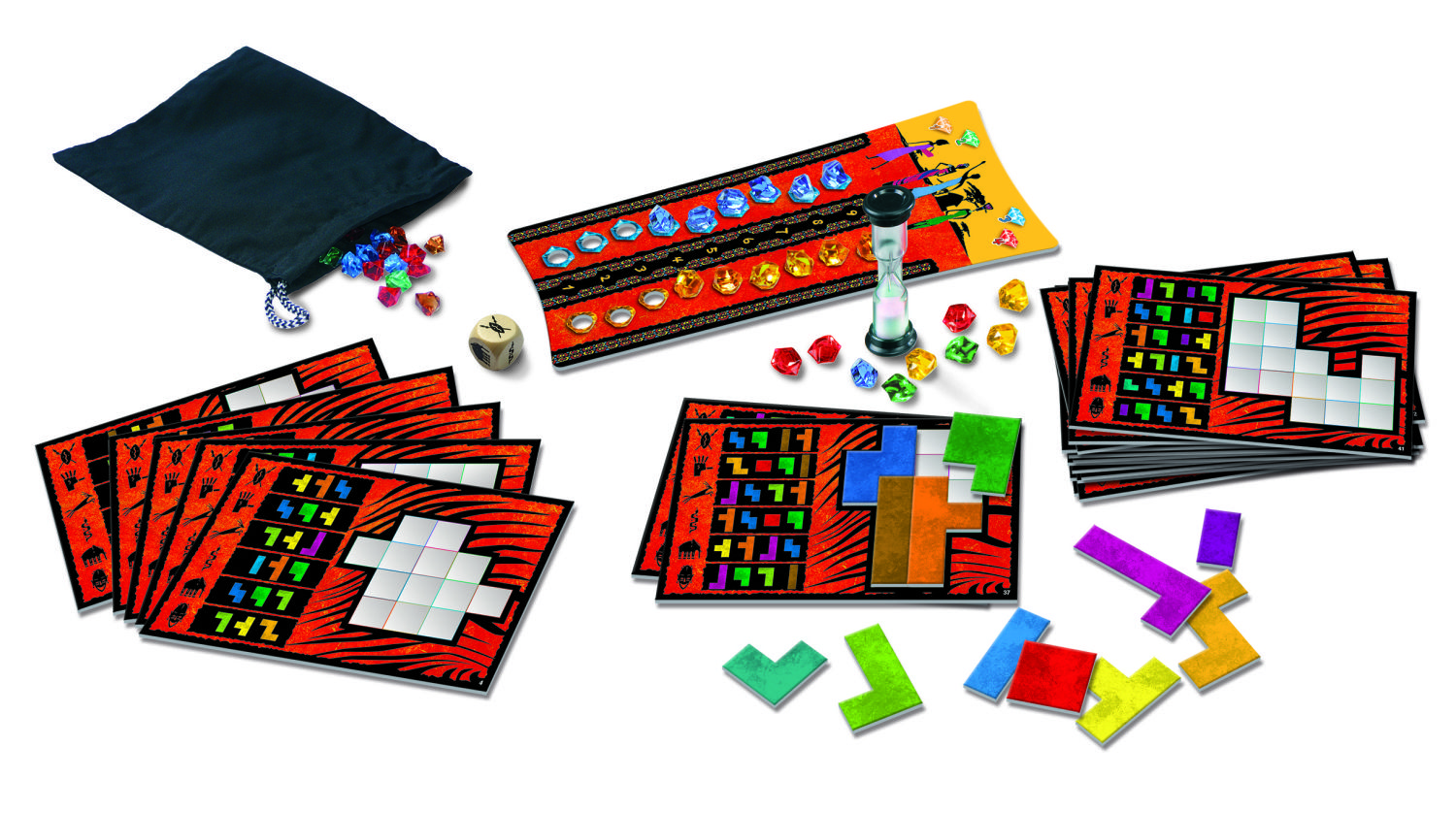Looking to put the mechanics of your mind to work and have fun doing it? Look no further than Ubongo, the African-themed dissection puzzle game from Thames and Kosmos. Designed for two to four players, Ubongo offers two different levels of difficulty and gets everyone involved. So clear the table and cancel those plans—it’s game time!
Ubongo, which means “brain” in Swahili, takes almost no time to set up. Game components include a die, an hourglass, assorted gems, a game round track, colored tiles, and puzzle boards. There’s even a soft cloth bag to store those priceless, translucent gems. All 36 puzzle boards are double sided, with six possible puzzle options per side. One side of the board shows the easy tasks, which only require three tiles per puzzle, while the other side shows the more difficult, four- tile tasks. Now if my math serves me correctly, that’s a total of 432 unique puzzles, providing kids and families with countless hours of unique game play.
To start the game, nine blue gems and nine brown gems are placed into corresponding holes on the game round track. These gems track the round number and serve as rewards for round winners. Each player receives a set of twelve tiles (one of each color and shape) and a puzzle board. Each task is marked with a unique symbol, which corresponds to one of the symbols on the die. For your first game, I would recommend starting off easy until you get the hang of it. But if you’re feeling ambitious, I won’t stop you!
 A quick roll of the wooden die indicates which shapes will be used to solve the puzzle. One swift flip of the hourglass sends the fine-grain white sand trickling down, and players race to finish first. Using specific tiles, players must form a certain shape using all of their pieces. It’s a modern twist on the classic tangram puzzle and reminiscent of the ever-popular Tetris. The first to finish gets to shout “Ubongo”, which, in my opinion, is satisfying enough.
A quick roll of the wooden die indicates which shapes will be used to solve the puzzle. One swift flip of the hourglass sends the fine-grain white sand trickling down, and players race to finish first. Using specific tiles, players must form a certain shape using all of their pieces. It’s a modern twist on the classic tangram puzzle and reminiscent of the ever-popular Tetris. The first to finish gets to shout “Ubongo”, which, in my opinion, is satisfying enough.
Gems are then divided amongst participants based on the order in which they finished, with different colored gems worth a different amount of points. For example, the fastest player to fit the tiles exactly into their placement area takes one blue gem from the track and blindly chooses one from the gem bag. The second fastest player takes one brown gem (worth less) from the track and also blindly chooses from the bag. The remaining players only get to choose one gem from the bag. Though Ubongo is a game of both skill and chance, it certainly pays to be fast! After nine rounds, the player with the most valuable gems wins. Just keep an eye on any younger kids who may get a hold of the gems – they are small and could pose a choking hazard.
I was able to complete a majority of the more difficult puzzles before the hourglass (which lasts about a minute) emptied. Despite my best efforts, I failed to solve a couple in the time allotted but, you win some and you lose some… right?
Ubongo is sure to get kids’ minds moving a mile a minute, offering them the educational opportunity to build on their visual spatial skills and problem solving abilities. It’s a game well suited for the entire family, combining the allure of puzzle and the excitement of a little friendly competition.
There’s really only one thing left to say: Ubongo!


